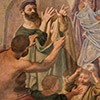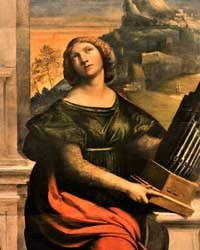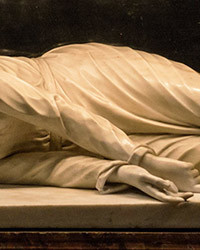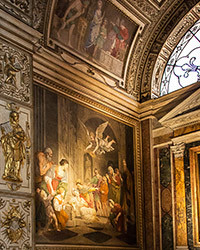Saint Cecilia Distributing Alms to the Poor– a story of the recalcitrant Roman populace
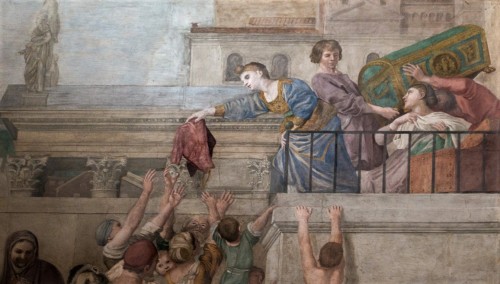
Domenichino, Saint Cecilia is giving alms, fragment, Chapel of Polet, Church of San Luigi dei Francesi
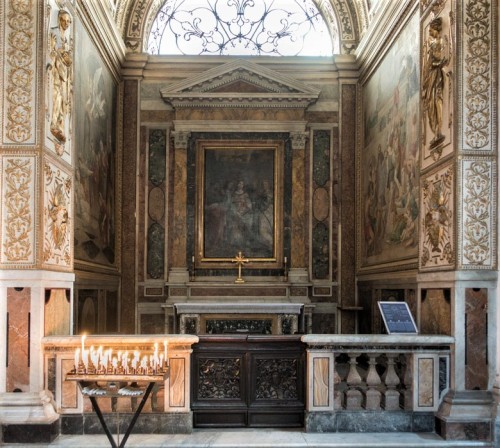
Polet Chapel, Church of San Luigi dei Francesi - a series of frescoes dedicated to St. Cecilia, Domenichino
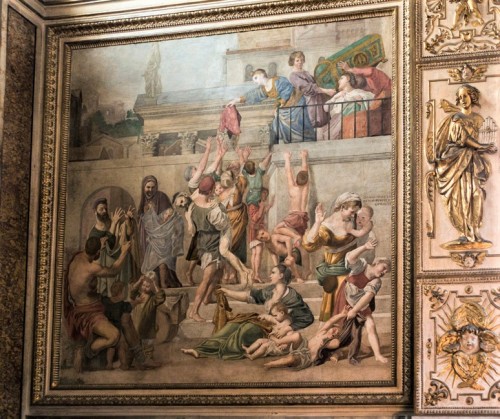
Domenichino, Saint Cecilia is giving alms, Chapel of Polet, Church of San Luigi dei Francesi
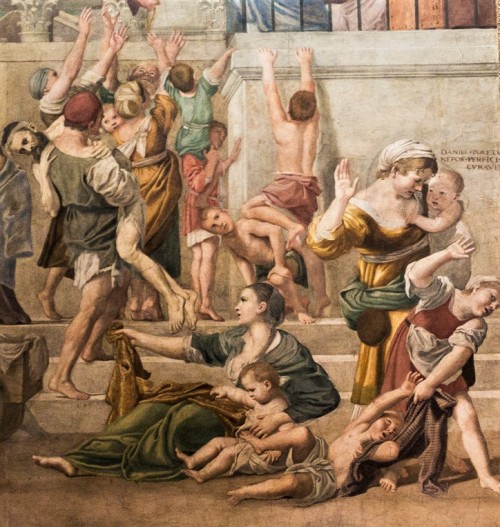
Domenichino, Saint Cecilia is giving alms, fragment, Chapel of Polet, Church of San Luigi dei Francesi

Domenichino, Saint Cecilia is giving alms, fragment, Chapel of Polet, Church of San Luigi dei Francesi
Pierre Polet desired that his posthumous chapel be decorated with frescoes by Domenichino. There would be nothing extraordinary about this undertaking, had it not been for one of the painted scenes, which surprised and disgusted many of the onlookers. What was it that shook the public of seventeenth-century Rome to such an extent that this painting was on the lips of both the educated elites, as well as simple people? In order to answer this question, we must carefully look at the decorations of the Polet Chapel located in the right nave of the Church of San Luigi dei Francesi.
Pierre Polet desired that his posthumous chapel be decorated with frescoes by Domenichino. There would be nothing extraordinary about this undertaking, had it not been for one of the painted scenes, which surprised and disgusted many of the onlookers. What was it that shook the public of seventeenth-century Rome to such an extent that this painting was on the lips of both the educated elites, as well as simple people? In order to answer this question, we must carefully look at the decorations of the Polet Chapel located in the right nave of the Church of San Luigi dei Francesi.
In a richly decorated with marbles, stuccos, and gildings chapel the most interesting is the fresco depicting Cecilia distributing alms to the poor in Rome. According to the legend, after Cecilia had convinced her husband and brother-in-law to become Christian, all three of them occupied themselves with burying other faithful condemned to death and helping the poor. In the painting, Cecilia is standing on the terrace of her house and is distributing her exquisite robes and fabrics to people gathered around it. Behind her, we can see a kneeling servant giving her more dresses as well as two men carrying in a chest, most likely also containing clothing. Behind the wall separating Cecilia's house from the street we can see pagan Rome, with its porticos, Corinthian columns, and statues of deities – a world which the future saint decided to abandon, becoming a Christian and an ascetic.
Help for the needy and the popularization of the idea of the seven corporal works of mercy (feed the hungry, give water to the thirsty, clothe the naked, shelter the homeless, visit the sick, visit the imprisoned, and bury the dead), became particularly "fashionable" after the Council of Trent (1563). The conviction that service to the poor and the needy is salvation for the soul, had been formulated since the beginning of Christianity, but in the post-Trent period, these ideas were popularized with particular emphasis.

On Domenichino’s fresco Cecilia and the people accompanying her take up more or less one-third of the composition, the rest is devoted to those receiving the gifts – the poor standing under the wall, creating a full of vigor genre scene. We can see the stretched-out arms of men, women, children, and the elderly, as well as their hands wanting to grasp the gifts, pulling the fabrics. The woman standing nearest the wall with a newborn in her arms is trying to reach the material which Cecilia is giving to her, one child is climbing onto the shoulders of another to try and take it from her, but it seems that yet another woman is going to get it, with her arms raised high. On the other side, a boy is climbing the cornice, hoping for some more spoils. A man is carrying an elder in his arms in order to (perhaps) elicit mercy and thus gain a better position in the struggle for the gifts. Below, on the steps, those who had already received presents, look at what they have gained. A little girl is trying on a dress that is much too large, while a merchant standing nearby, is showing a seated woman, how much he is willing pay her for a piece of brocade. Another man standing a bit further shows off his own fabric, hoping to get a good offer for it. Next to him, two small boys are playing with a satin hat, probably also thrown off the balcony. The closest to us we can see a mother with three children, out of which two are fighting over some loot. The impatient mother raises her hand to strike one of them. The commotion which we are witness to does not bring about the feeling that we are seeing people who are happy about their gifts and appreciate Cecilia's gesture. We have to admit that, what was supposed to be an object of praise, meaning putting into practice the slogan "clothe the naked", arises contradictory emotions. From our current point of view, even throwing gifts from a balcony is somewhat humiliating for the poor, but that is not what the then public was upset about. The generous donor did not interest anyone. It was the behavior of the impoverished gathered at the wall, that was analyzed with great scrutiny. The artist was criticized for too much genericness of this scene of haggling and arguing as improper for the interior of a church. But there were also those who believed that the representation showed the truth of the brutality of life and was a good depiction of the common people. What was it that Domenichino really wanted to impart in creating a scene which shows people as brutal and rapacious beings? Why does he show a populace that is blind, not only unappreciative but one that does not even notice Cecilia’s charity?
In this context, an especially interesting motif is the comparison of the figures of two women presented by the artist – Cecilia, leaning down from the balcony with a piece of fabric in her hand, and the other woman sitting on the steps with a child in her arms, picking up another fabric, which is reminiscent of a well-known in the artistic world allegory of Caritas. And while Cecilia is giving away her possessions, the woman is offering them to a merchant. Here we are dealing with selfless love of a fellow man and its direct opposite, meaning the desire for gain and profit, all expressed allegorically. Of course, we may ask, what was the poor woman supposed to do with a piece of brocade offered to her, when she had no money to feed her child, but this was not the topic of the artist's fancy concept. Charity and the love of our fellow man make sense, that is what Domenichino seems to be saying, even in the face of ingratitude. We come closer to Christ here on Earth, the same as Cecilia who forgoes all luxuries but may expect rewards not here in this world, but given out as eternal life. This message put works of mercy at the forefront and was directed to those who were able to and wanted to bestow gifts upon others, but it also addressed the ones who received gifts, whom the post-Trent Church also wanted to reach out to with the message of the Gospel. And it was they, who, through an easily-understood anecdote, gestures, facial expressions, and movements of the painted figures, could see themselves – as if reflected in a mirror, but they should also notice and comprehend the message of mercy directed to them. Art was to elevate the reasonless Christian, arise within him a reflection on life, and improve him in the moral dimension. Generosity, piousness, purity, and the love of your fellow man represented by Saint Cecilia could have been imitated by everyone, regardless of their social status. Praying to Cecilia and imitating her deeds was especially recommended to women, for whom, after the miraculous discovery of her body untouched by decomposition (Maderno’s Statue of Saint Cecilia), she became a particularly important protector and intercessor. Miracles of healing that took place at the Church of Santa Cecilia on the Trastevere, on the day of her second burial, were upon the lips of the entire Roman populace, which came to her in hope of support and aid.

In commissioning this rather unpopular scene from Domenichino, Pierre Polet had his own reasons. He himself was a member of the Brotherhood of St. Louis active in the Church of San Luigi di Francesi, one of the numerous secular organizations which brought together the rich, who gave money to charity – to single mothers, orphans, fallen women, or those who were dying on the streets and had nobody who would take care of their burial. This is what the Brotherhood of St. Louis occupied itself with, and probably they did not often meet with words of thanks. Undaunted by this fact Polet, saw a higher (heavenly) purpose in providing aid to those in need and he wanted to share this conviction with posterity.
Domenichino was an artist who was considered a master of the so-called historical painting – skillfully creating a real world, full of expression visible in gestures and movements of the painted figures, but he was also a painter, who creatively processed the works of Raphael - an artist who was considered a genius in this field. Using quotations from the Prince of Painters, which the discussed painting is filled with, not only was not criticized but it was recommended and praised. Comparing Domenichino's fresco with the famous fresco The Fire in the Borgo in the Apostolic Palace (Raphael’s Stanzas) allows us to see a veritable plethora of them.










